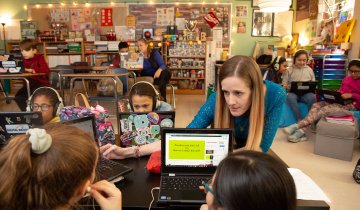What role should students play in their civics education?
This question has come into focus in the debate over how civics should be taught in K–12 schools. Under a more traditional model, civics curriculum focuses on content knowledge, emphasizing the basic facts and functions of government. However, a growing movement calls for students to play a more participatory part.
Action civics refers to the direct participation of students in democratic processes and organizational efforts as part of a civics curriculum. For additional context, here are six things education professionals should know:
1. Action civics prioritizes student engagement
Action civics is founded on the idea that students can learn civics by doing civics. In addition to providing important knowledge about political systems, programs seek to empower young people by having them take an active role in issues that matter to them.
“Students who learn civics through more active and participatory learning experiences will develop a deeper, more meaningful understanding of what civics is,” said Assistant Professor of Clinical Education at USC Rossier Akilah Lyons-Moore. Active learning also highlights the “roles and responsibilities of individuals, including themselves, and groups within a society.”
2. Programs are rooted in research
Action civics programs draw on youth-led participatory action research (YPAR) concepts. In practice, students identify an issue that affects them and their community, collect and analyze more information about the issue, and use data to plan a course of action. These activities are included within a broader civics curriculum.
3. Action civics meets student interest in activism
Action civics has gained attention as young people have become increasingly engaged in social issues. While activism has been commonplace on college campuses for decades, younger students are now more engaged in cultural issues such as climate change, gun control and racial justice, sharing resources and participating in protests to raise awareness and demand action from political leaders.
4. Programs provide opportunities to marginalized students
For low-income school districts that serve marginalized populations, action civics programs address the issue of traditionally low civic engagement among students.
According to research cited by the National Center for Biotechnology Information (NCBI), “[civic] opportunities that do exist are unequally distributed across schools and neighborhoods, and race and socio-economic status are strongly predictive of civic preparedness and participation.”
5. Advocates highlight improved outcomes
Proponents of action civics say—and research corroborates—that civic engagement and community service among students has positive effects including:
- Increased civic engagement later in life1
- Greater civic knowledge2
- Improved self-efficacy, or the belief in one’s own ability to succeed3
- Improved academic outcomes and attendance4
- Developed leadership skills and other competencies5
6. Critics favor a more traditional approach
Some critics argue that action civics prioritizes activism at the expense of content knowledge. It also de-emphasizes the role of traditional political processes. Instead, students should be provided with facts about government and encouraged to choose their own level of participation.
References:
1, 2, 3National Center for Biotechnology Information
4Education Resources Information Center
5The Center for Information and Research on Civic Learning and Engagement





